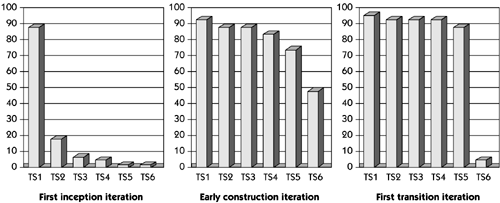Performing the Assessment
| The elements of the requirements sets in the rightmost column of Table 29-1 are tangible artifacts that can be reviewed, assessed, and reasoned about. However, since the process is iterative, the question naturally arises as to how to measure artifacts that are changing over time and are, technically speaking, never complete. In other words, can we actually measure something that is moving without stopping it first? Well, of course, we have to try. The answer to our dilemma is twofold.
With respect to the latter, we'll see artifacts with varying breadths and depths of completeness over time. In order to assess them, we just have to know what to expect and when to expect it, and that depends on what iteration we are in. If we look to the iterative model for hints, you can envision that the state of these artifacts evolves over time, perhaps as Figure 29-2 illustrates. At each checkpoint we simply need to understand what level of completeness we should have achieved by that state and then assess accordingly . Figure 29-2. Completeness of requirements sets at various iterations |
EAN: N/A
Pages: 257
